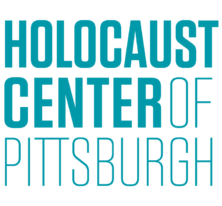American Winners

GRAND PRIZE WINNER
3D Art-High School
Escaping Butterflies by Ryan Neal
Avonworth High School
I created a pile of gray butterflies surrounded by barbed wire to symbolize people killed in the concentration camps. The butterfly that still has some color and flies out represents the survivors. The colors are not fully present on the surviving butterfly to symbolize the mental and physical toll it caused on each Holocaust survivor. The butterfly escaping is based on a woman’s diary entry about having hope for liberation and not letting this dream go. Being surrounded by dead bodies and still have the will to live shows the Holocaust survivor’s extreme resilience.
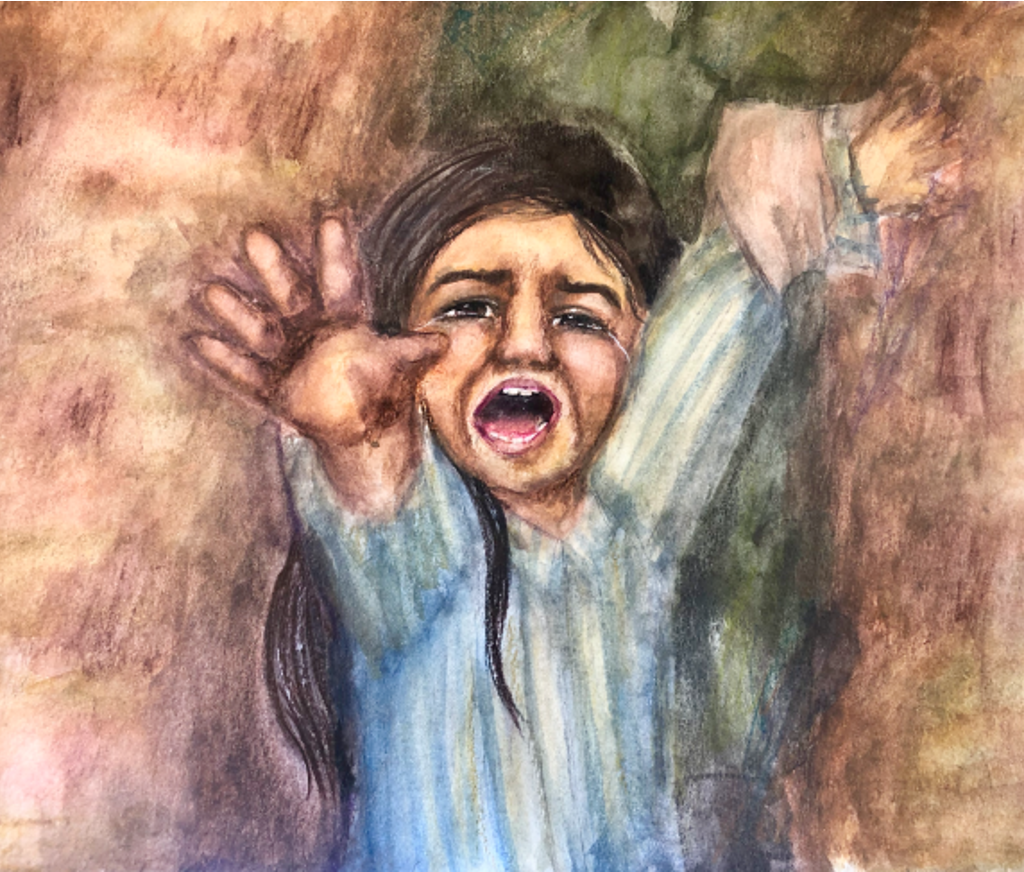
2D Art-High School
Mother(s) by Bella Burrell
Springdale Jr. Sr. High School
Mother(s) is a depiction of Rosa Kugelman’s point of view as her daughter, Stella, was separated from her upon arriving in Ravensbruck. Tear blurred colors, only seconds to remember your four year old’s face forever. Although Rosa ultimately does not survive the concentration camp this would not be the last time she and her daughter would meet. Through the help of other women in the camp Stella and Rosa would reunite once more. Not only did these women ensure Stella wouldn’t forget her mother, but protected her in Rosa’s absence. Stella survived Ravensbruck, having only her camp mothers and her own resilience to blame.
Soldiers march in the streets of Germany
Moving swiftly, grasping the arms of the innocent
Pushing those deemed undesirables from their homes
Relocation to their demise
The lucky ones can turn a blind eye
Red roses perk up, a prominent sight in the deep darkness
Who is to stop this?
Who is going to care?
Opposition blooms, it’s summertime in Munich
Papers gathered up anonymously, thrown in the streets
Five against hundreds, rare but hopeful
Safety at risk, but the cause is worth it
The red roses were fully flourishing, a falsely bright view. No end in sight to their spread.
Leaflets floating around, the dangerous opinion incites frustration
The Gestapo finds out, furious about the radical notions being spewed.
Soon enough, arms rise in innocence,
But not in the eyes of the enemy.
Winter falls, the red rose petals soon follow.
Unsuccessful in their protests
The five faced arrest.
Two were sentenced to their deaths.
All the time spent denouncing evil seemingly wasted.
As the final red petals fell, new seeds rolled too.
Years later after liberation,
A new bud forced its way through the dirt.
The weeds of the red roses littered the ground, soon pulled up by the next generation
Suddenly, a genuinely peaceful sight emerged.
Red petals fell, but a White Rose bloomed.
Poetry/Graphic Prose-High School
Fresh Seeds by Sydney Finnigan
Shaler High School
“Fresh Seeds” is inspired by the White Rose movement that emerged to oppose the vicious rule of the Nazi regime. Five students organized an anonymous leaflet discouraging citizens of Munich from supporting Hitler and his hateful policy. Literature reaches vast audiences and can be used to commemorate a cause symbolically. White versus red historically represents peace over hate or anger, The White Rose advocated for that specifically. Although their efforts seemed insignificant at the time, their act of resistance is remembered and taught today, showing that change is possible through the courage to stand up and speak out.
Essay-High School
Antisemitism Through the Years by Caroline Sweeney
Avonworth High School
When the word antisemitism comes to mind, the Holocaust tends to be the first event thought of. However, antisemitism is way more than what happened in Germany during the 20th century. While this was a horrific event that took so many innocent lives, it helped to bring attention to the issue of antisemitic behaviors and actions. For better understanding, the word antisemitism means “hostility to or prejudice against Jewish people”, according to Oxford Languages. For thousands of years, Jewish people have been persecuted and shamed because of their religious beliefs. From public humiliation to deaths in concentration camps, people of the Jewish religion have been put under such terrible circumstances. While many appalling events have occurred throughout time, the Jewish population has remained faithful.
The beginning of Jewish hatred came about when the Christain religion was formed. The video, Why the Jews: History of Antisemitism, says how Christians and the Christain religion made Jewish people look bad and would even go as far as to compare them to the devil. This was an insult because, in the Christain religion, the devil is the ruler of all evil, and is frowned upon. Not only would Christians make such a terrible comparison, but would also say that Jewish people would poison water wells which then caused the deadly black plague (Why the Jews: History of Antisemitism). This not only started a bad rumor but made people afraid of the Jewish people.
It is important to look at the change in antisemitism that occurs at the end of the 19th/beginning of the 20th centuries when Judaism was no longer considered a religion but rather a race. Many of the present-day examples of antisemitism have ended deadly. In 2018, the neighberhood of Squirrel Hill, a predominantly Jewish neighborhood in Pittsburgh, was shot upon during a service in the Synagouge. This event killed eleven innocent worshipers and injured six. This was the most deadly antisemitic attack that has ever happened in the United States. When this event happened, people all around the United States came together to support one another, and to show that antisemitism does not have a home in our country. It took eleven innocent people to die for people to realize that the issue of antisemitic behaviors was still relevant in today’s society. In most cases, society does not realize that something is wrong unless a terrible action happens.
Efforts to end antisemitism have varied and changed throughout time. An example of efforts to protest and end antisemitism was during the Holocaust. The comic The White Rose, written by Wayne Wise illustrates the backstory and purpose of this actual group. In the comic, a brother and sister named Hans and Sophie Scholl were Christain children during the Holocaust. Sophie, in particular, joined on her own accord and was a supporter of the Nazi party throughout the 1930s despite her parents not liking it. After realizing what the Nazis stood for and the things actions done to Jewish people, when Hans and Sophie were grown, started a group at their college to protest the Nazis and Hitler. Being a Christain and standing up to the Nazi party shows just how wrong she and her brother thought it was. Their writings were found which lead to Hans and Sophie getting sentenced to death and killed. Allied forces got ahold of their “leaflets” and dropped them all over Germany as a form of propaganda to spread awareness about the Nazi regime. While this group ended in persecution, their bravery and boldness helped to get the message out all over Germany. Present-day examples of protesting antisemitism were done after the Tree of Life shooting. People all over Pittsburgh, and the United States, made t-shirts and other forms of clothing with the words “Stronger Than Hate”. Even with all of these protests and the recognition of antisemitism, more work needs to be done until it is completely eliminated from the world.
While antisemitism started as rumors and spreading hatred towards the Jewish community; it has escalated to real violence. A common theme that both past and present antisemitism has in common; is the root of the issue. The issue, in this case, is White Supremacists. These people fear that Jewish people and other minorities will strip white people of their position in society. The article, “Skin in the Game: How Antisemitism Animates White Nationalism”, discusses how White Supremacists think that the white minority is superior in the human race. These types of people see Judaism as a race, instead of a religion meaning that White Supremacists thought that being Jewish was genetic and was based on blood and physical features. The Nazi regime and Hitler helped to promote this and change society’s mind by pointing out physical differences, and segregating them form the rest of Germany, It is important to note, that the theory that Jewish people wanted to overthrow White people is extremely wrong. This misconception has caused so much damage that is irreversible. While it has been proven wrong, hateful people still fail to see that what they think is in their head, and not realistic.
It is key that the United States, and even other countries worldwide, learn about antisemitism and the effects it has on not only the Jewish population but our world in general. The saying “history repeats itself” is very true, and can be shown through antisemitic events. After the Holocaust, everyone said that this would never happen again, yet our world has let it. Studying the Holocaust in specific can help realize the severity of antisemitism and the negative effects it has had on the Jewish population in years after. Getting educated on this issue will help to stop these acts of hate. If not, time and time again the Jewish community will be persecuted and thought of differently. If everyone learns to respect one another’s beliefs the world can become more bright and more hopeful.

3D Art-Middle School
Holding Disparate Truths by Anna Campbell
Quaker Valley Middle School
My sculpture symbolizes two different mindsets exhibited by Jewish prisoners residing in Nazi concentration camps. The left hand holds resignation, defeat, and despair symbolized through clay gravel, thorns, and waste. In contrast, the right palm contains resilience, hope, and opportunity depicted as fertile ground, colorful flowers, and growth. The barbed wire wrapped around the cuffed left hand shows imprisonment both in body and mind; while the elevated opposing hand uses intertwined vines representing life yet to be lived after liberation. “When we are no longer able to change a situation; we are challenged to change ourselves.” -Viktor Frankl, Holocaust survivor
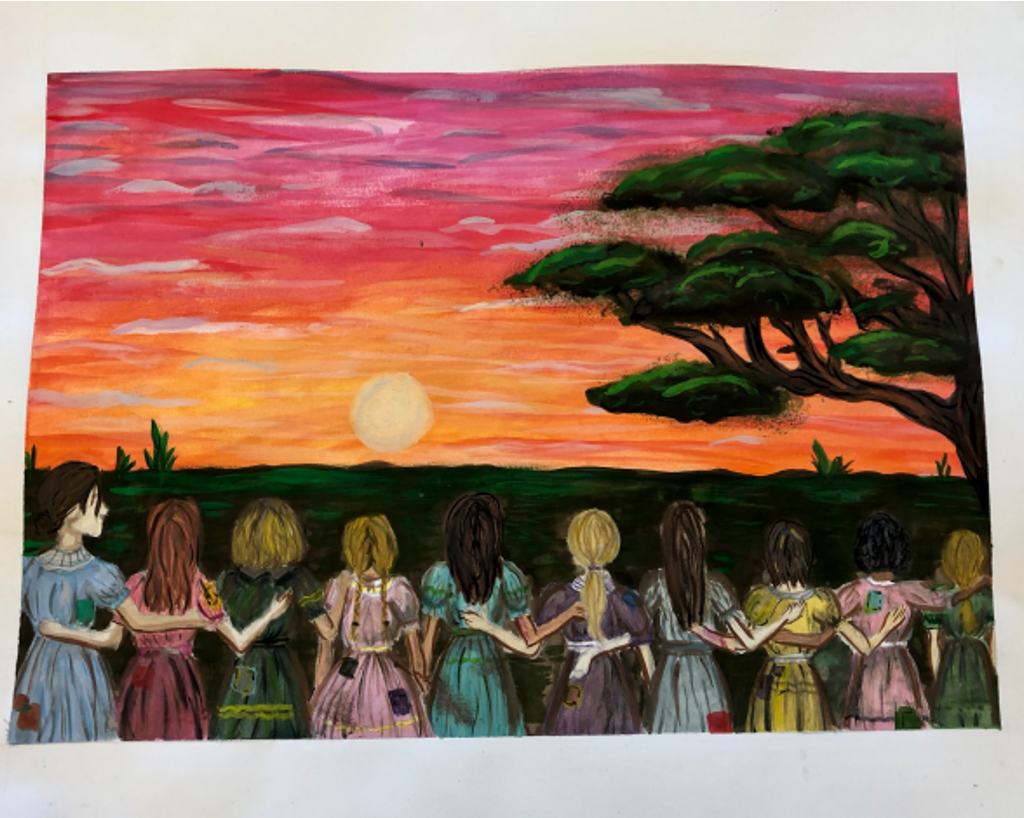
2D Art-Middle School
Resistance and Resilience in the Holocaust by Ariana Caltagarone
Springdale Jr. Sr. High School
My expression of resilience in the Holocaust is a painting based on a powerful woman. Sara Fortis, born in 1927 in Chalkis, Greece, and raised by her widowed mother, who faced the Germans in 1941. She was isolated, and she decided to become a resistance fighter. She would then go to other villages and recruit other young women willing to fight. I created a painting symbolizing these individuals in their comradery and strength. The contrast between their dull clothing and the bright surroundings symbolizes the sadness in war compared to the brighter times ahead.
Like Csak like Owens
Like Ratjen like Mayer
As fast as I run
As high as I climb
Even if I’m just an inch from the finish line
I refuse my devotions
To step on the podium
I would be a betrayer
I will not solute
Nor will I heil
Because it would mean
That they would prevail
Because what happens to those
Who are left behind
Replaced and forgotten
Not because they were unnecessary
Not because they were useless
But because they were simply Jewish
Poetry/Graphic Prose-Middle School
מספיק טוב by Maggie Watson
Quaker Valley Middle School
The free verse poem “מספיק טוב” shows the resistance and resilience of many people, especially Jewish athletes. “מספיק טוב” ‘good enough’ is the message. Jewish athletes were denied access to teams and clubs including the Olympics, no matter how good they were. Athlete Margaret, says she felt even if she competed she would be thought inadequate. Names listed in the poem are Jewish athletes who made it to the Olympics. Their scores could have won, but they were denied entry. The last lines symbolize the resistance of the few Jewish athletes who were offered to compete but refused, instead boycotting.
Israeli Winners
Once the decision was made, my skies were shut
No bird to be found
No bird that was created
My whole diary is a cry for help
Existing here within four walls
Due to my gender speaking to machines
That is not how I was created
My whole diary is a cry for help
For help… because I am
Stuck, stuck, sitting here, sunk
In quicksand, who am I? who am I?
I know, I know, I am here, sinking
In my hope, is this me? This is me
With my diary before my eyes alone
And solution is nowhere in sight
Knowing this is my calling
I am only allowed to wait, pulse beating
With my diary before my eyes alone
My feet already exhausted
But I am still alive
So I cannot just wait anymore
Even though… I am
Stuck, stuck, sitting here, sunk
In quicksand, who am I? who am I?
I know, I know, I am here, sinking
In my hope, is this me? This is me
In my hope to help, to contribute
My war is not inside these walls
Since this is not where I was created
My whole diary is off to war
I have decided to open my skies
Because a bird was created here
Because it is not just bravery
My whole diary is off to war
Creative Writing-1st Place
My Whole Diary is Me by Ron Peer
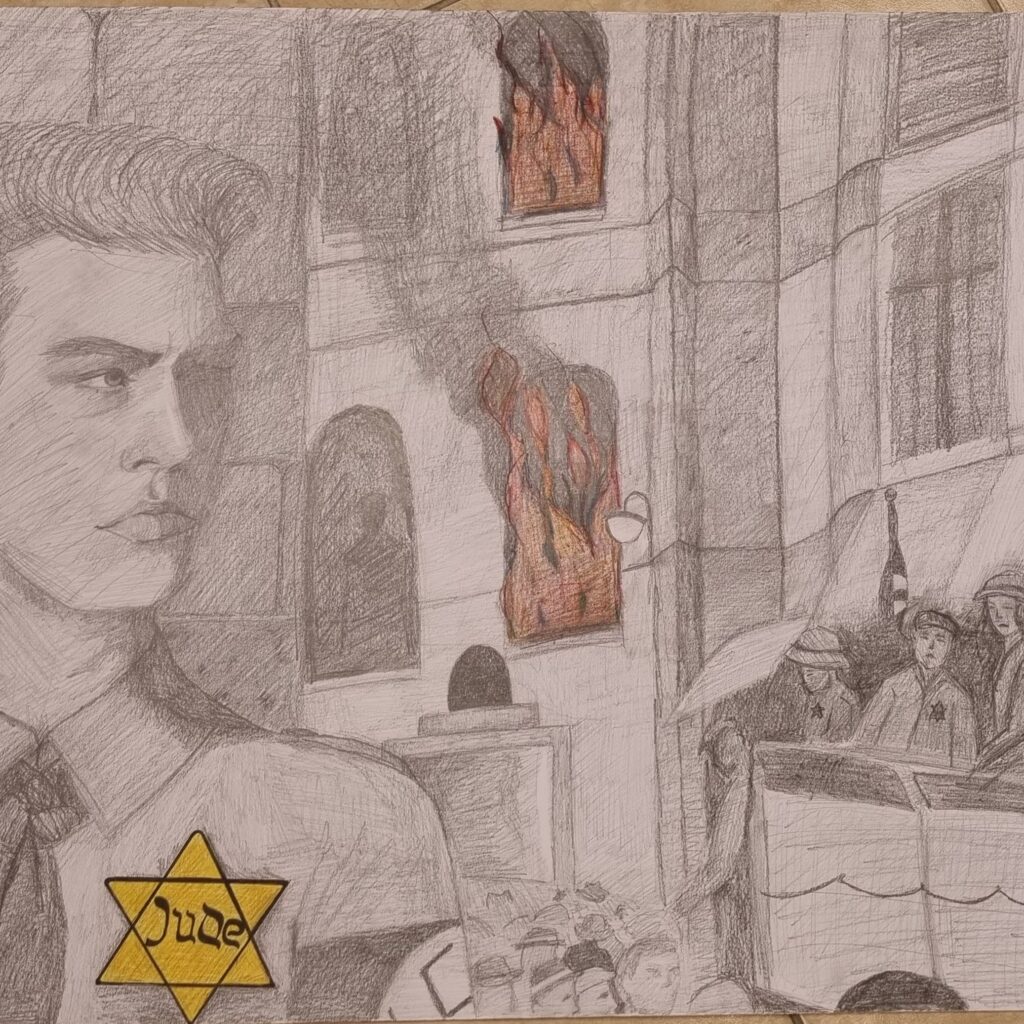
2D Art-1st Place
The Inner Underground by Liv Uzan
Holocaust victims and survivors showed resilience through the choices they made during or following the war. When I read this sentence, I thought how accurate it was and how well it fit Shlomo Perel’s story and the message I wanted to deliver through my artwork, and then the parts were just pieced together.
I used three original sources in my work – two photographs and a biographical book, each containing different memories, different testimonies, and different forms of resilience from different periods of time, and I combined these three sources into one piece of art.
Shlomo Perel and his fascinating book, Europa, Europa have been a great inspiration for me. Shlomo, a young boy from a Jewish family, showed his resilience through the choices he made, which led him to spin a web of lies so that he might survive. Shlomo Perel (Joseph Preil by his German name) spent most of the war under a false identity of a German soldier. Making a life out of concealing the truth and constantly having to improvise in his struggle to stay alive, he had to go into an “inner, carefully disguised underground”. I chose to draw Shlomo’s face, expressing his persistence, his determination not to break down, to confront all dangers, to keep playing the role of the German soldier that actually saved his life. I drew him dressed in his Wehrmacht uniform, yet in his heart he never forgot he was Jewish, and thus I added the yellow badge, which symbolizes to me the harsh rift he had to live with every day for several years.
The Warsaw Ghetto Uprising is the most significant symbol of Jewish resistance during the Holocaust, where various Jewish organizations fought desperately, against all odds, to resist the immense power of the SS and prevent the transport of the few remaining Jews to Treblinka. The Germans were taken aback by the acts of resistance from the underground fighters and other ghetto residents who entrenched in hidden locations. I chose to draw the Germans’ retaliation acts and their attempts to oppress the uprising by setting fire to one house after another, smoking the last Jews out. While searching through photographs at Yad VaShem, one picture caught my eye, depicting Jews being driven away in a truck, probably to one of the camps. It reminded me of the photo of “the building on Moranovska St. #3 on fire” (from the archive of the Jewish Historical Institute in Warsaw), and I was inspired to combine the two pictures with no photoshop, in order to realize the cruel reality the ghetto residents lived in and the resilience they demonstrated in face of that enforced reality. I felt that working from one source was not enough and wanted to do something different, adding my own interpretation. Putting all the elements in the artwork and combining them together with all the stories, along with precise use of lines and paint, contributed to the feelings I was trying to convey and helped me to create a unique painting.
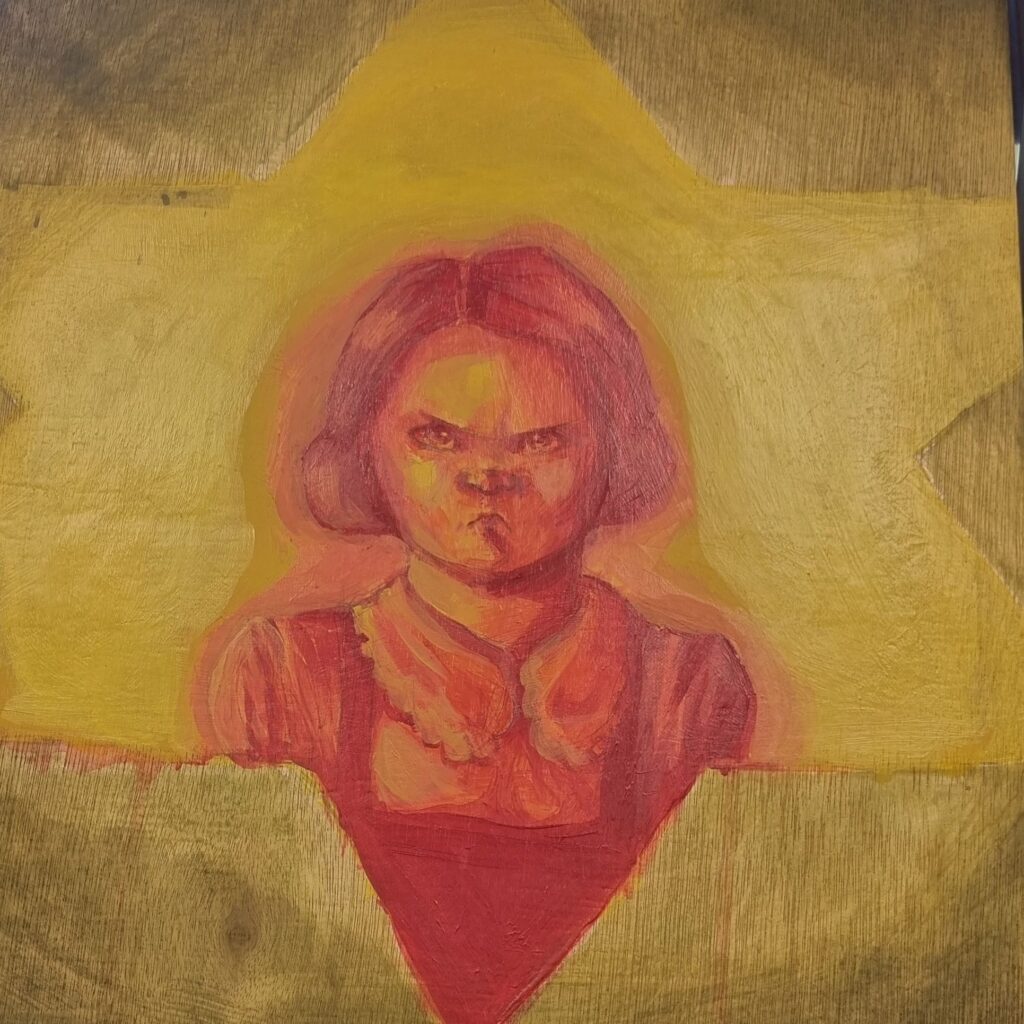
2D Art-2nd Place
The Jews’ Shield by Natif Shnir
The inspiration for my work was the story of Zipora Grant, a Holocaust survivor from France.
Being 11 years old during the Holocaust, Zipora demonstrated significant resilience. It allowed her to act boldly and remain strong in face of the Nazis, but it also made it harder, turning the weakness into a lot of anger and sadness. The shield that was made of her resilience guarded Zipora’s Jewish identity and was her only weapon against the Nazis, but this did not stop her from fighting back. That shield also served as a wall standing between Zipora and falling into weakness. When Jews expressed resilience in the Shoah, they brought themselves closer to death, but protected their Jewish identity. At the same time, Jews who sacrificed themselves gave strength to others not to give up their Jewish characteristics. The resilience demonstrated by Jews created an invisible shield around their persecuted people, guarding them significantly from the Nazis and their attempts to crush the Jewish spirit. I chose to physically realize this metaphoric shield in wood, on which I drew the yellow badge and Zipora’s image as a little girl. Her angry, militant expression stands in contrast with the usual images of children we are usually see in the black-and-white photos from the Shoah, implying the inner burning of Zipora’s resistance. The girl’s portrait is drawn in the way Roman admirals used to be sculptured, symbolizing Zipora’s fight back against the Nazis. The yellow Star of David represents how hard it was to live as a Jew back then, when Judaism was presented as a flaw. But Zipora kept her “flaw” nonetheless, refusing to give up her Jewish identity. The idea of the Jewish Shield came to me while I was listening to Zipora, unable to comprehend how an 11-year-old was able to walk into a Nazi chamber and say to a Nazi, right to his face, that he took away her parents and siblings and demand he bring them back. I can actually visualize a shield in her hand, like a single warrior taking off to the battlefield.
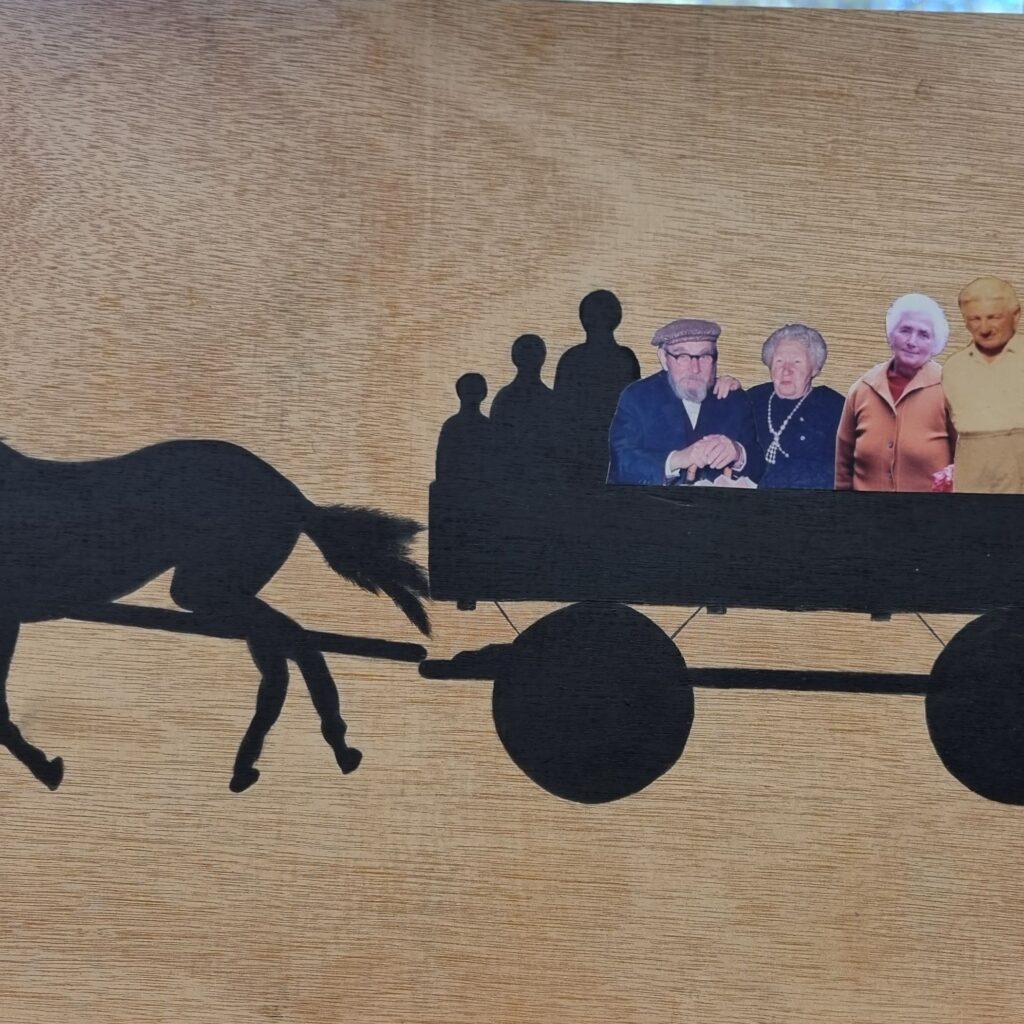
2D Art-3rd Place
Inside the Wagon by Reut Izak
Israel Isaac, my grandfather’s father, saved several family members and other Jews and, after losing his wife and daughter, managed to start a new family and also to give testimony in Germany. Dora Isaac, my grandfather’s mother, saved her sister twice from a selection. Aaron Grilak, my grandmother’s father, survived the Holocaust in the labor camps in Siberia, knowing that his wife and two sons were safe; when he came back, he discovered all three were murdered, yet he managed to remarry and start a new family. Paula Grilak, my grandmother’s mother, remained alone in the world after the Shoah, with no close relatives, and she built a new family for herself. When I realized that the theme of this contest was resistance and resilience, I thought first about Israel’s story, and it was important to me to present his courageous, most impressive demonstration of resistance in my work. But when I heard about the heroism and resilience of my other great-grandparents, I decided to include all of their stories, because all four showed their resistance, resilience, or both. I also chose to add Aaron and Israel’s first wives and children, because in my mind they were part of their resilience; not only have they survived, but they had lost their nearest and dearest and still they were able to rise again and start over at an older age.
In my work, I combined the stories of all my great-grandparents and their families together in the shadow of Israel’s wagon, which represents their resistance and resilience and how they all came together to create my family. The figures in my work are, from right to left: Rivka, Bella, Israel, Dora, Paula, Aaron, Yaffa, Shmuel, and Mordechai.
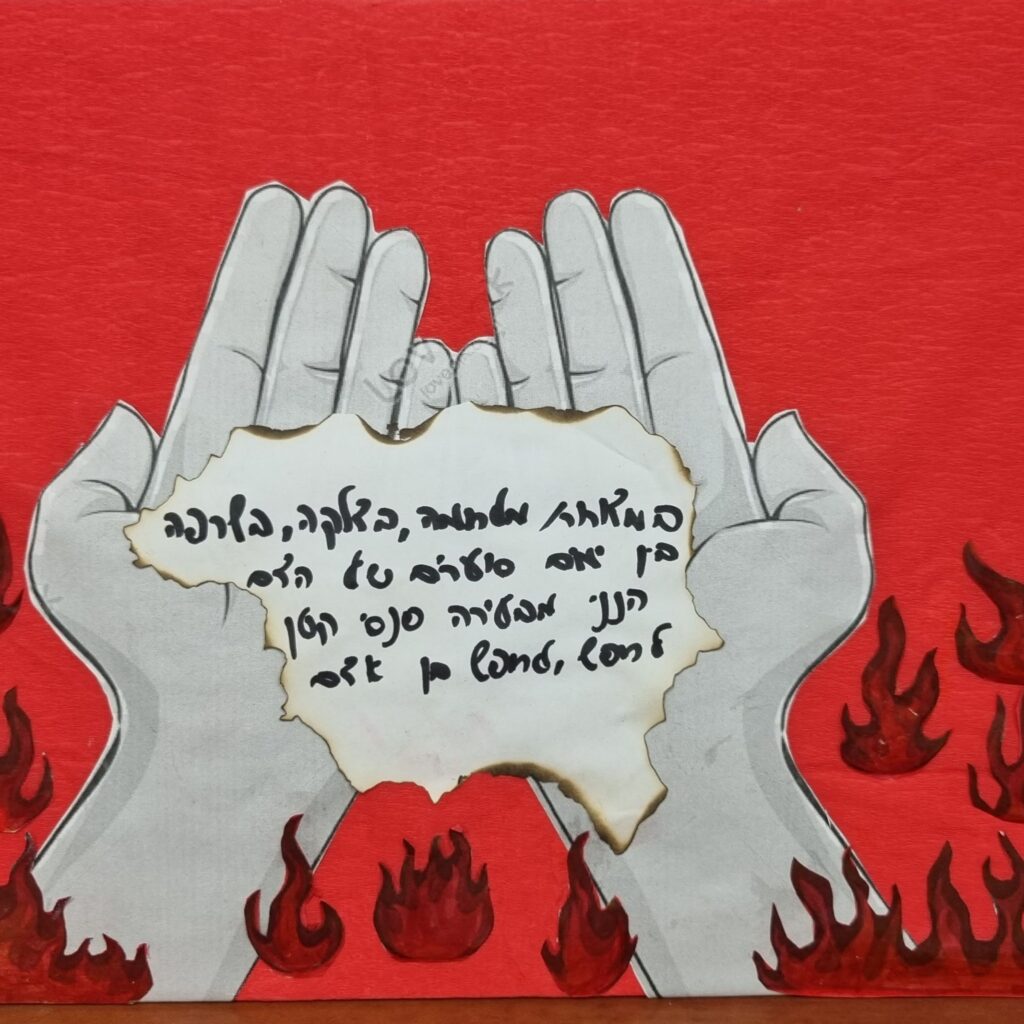
2D Art-4th Place
In the Fires of War by Lital Sproniak
Hannah Senesh’s poem, In the Fires of War, was the first one she wrote in Hebrew. She wrote it in the Girls’ Agriculture School in Nahalal, on October 11, 1940, only one year after arriving in Israel (which back then was the British Mandate of Palestine). Although here things were relatively quiet, the World War was already raging, and those events are reflected in every word of the short poem, which is at the same time universal and personal. In my work, I used the first paragraph of the poem [literally translated from the Hebrew]: In the fires of war, in the flames, in the flares, among stormy days of the blood, I am turning on my small flashlight, to search for a human being. The artwork shows a person’s hands, holding a piece of paper they had dug out from a fire, thus the paper is burnt around the edges, and the red color represents the fire, the blood, and the flames through which the person is searching to try and find another human being.
Polish Winners
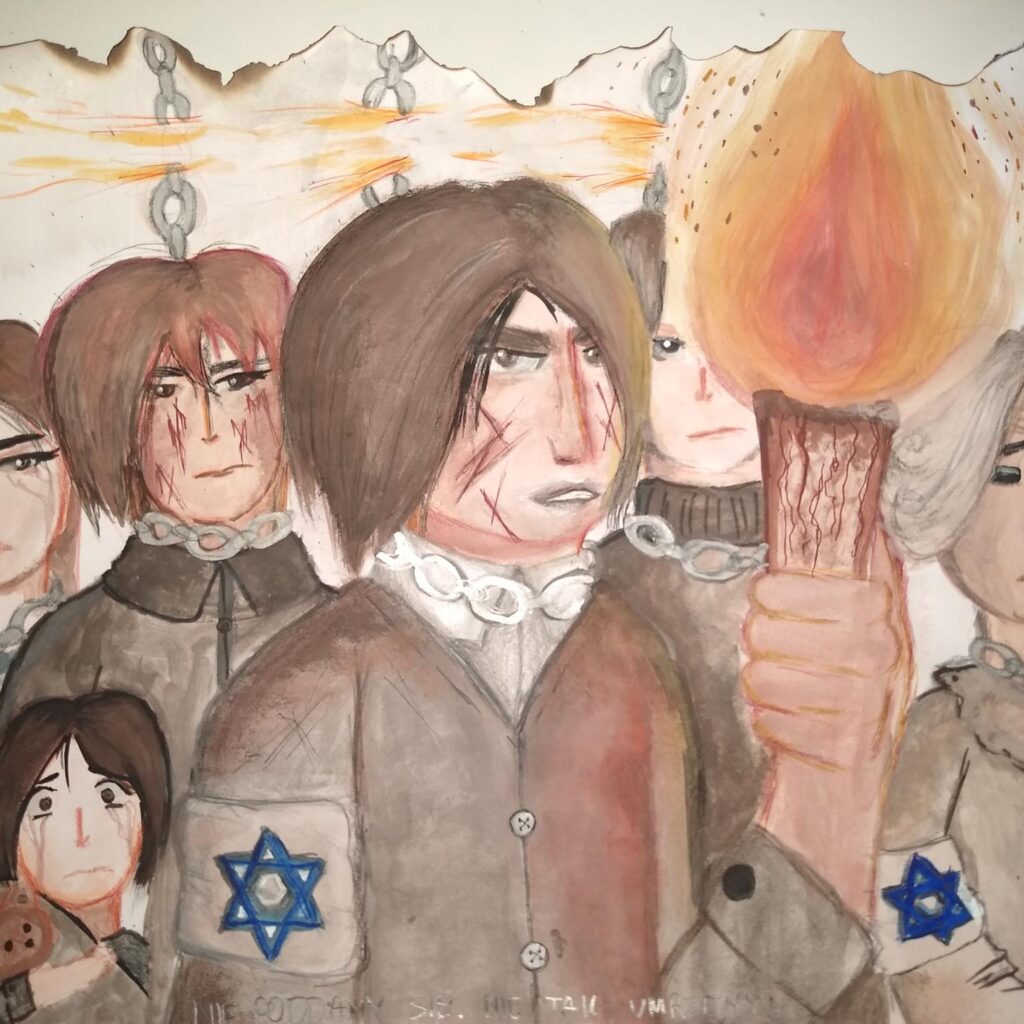
Painting-1st Place
By Karolina Zarzecka
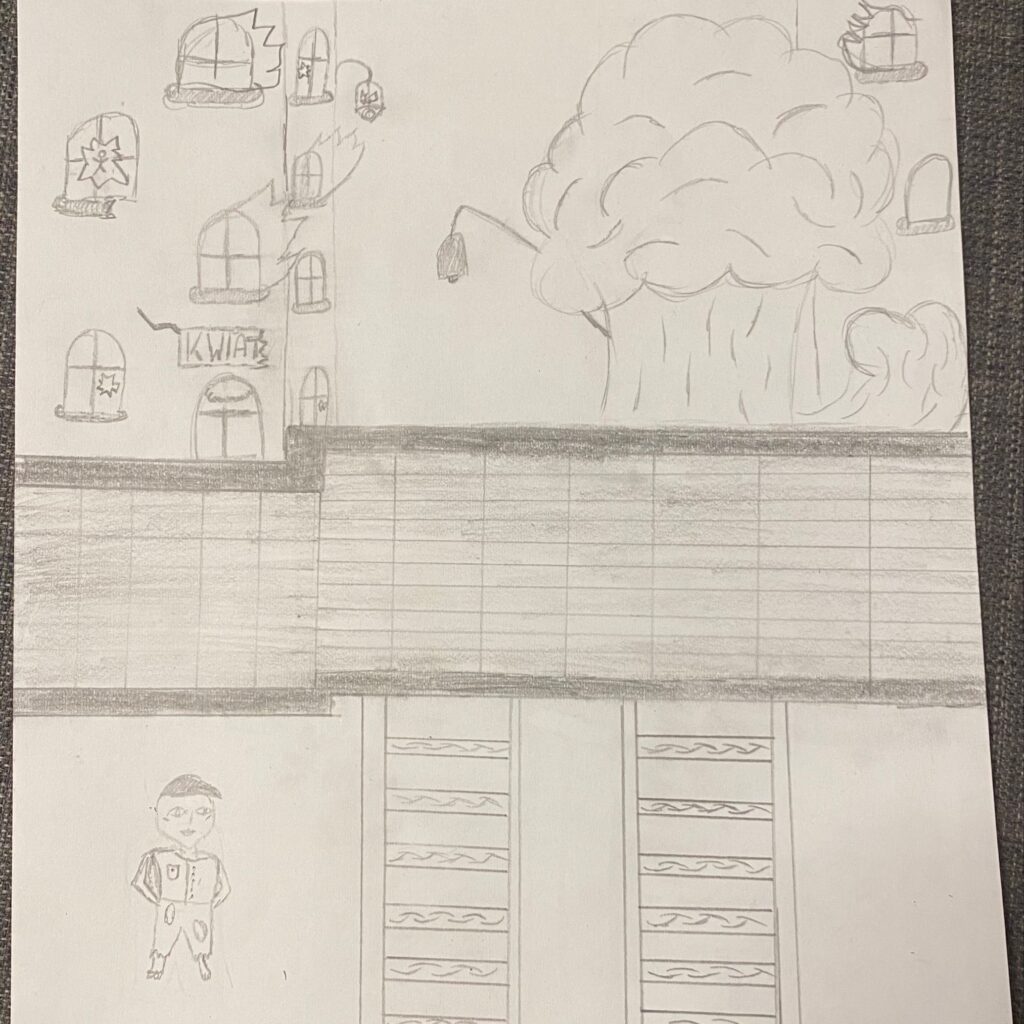
Drawing-2nd Place
By Maria Korwin
Writing-3rd Place
By Noemi Stankowska
“Resistance and opposition as an expression of individual strength”
Albert Camus said, “In order to exist, man must rebel,” and this is the greatest driving force of man.
Man is constructed in such a way that he will never agree to what he finds. People have always sought, resisted, and rioted. Rebellion is part of human nature. This rebellion is the driving force behind human activities, it was the source of the most perfect human achievements. Acceptance of what a person gets from the world does not generate action, it is a passive attitude. Rebellion forces you to be active.
Man, as a conscious individual, rebels against everything. The greatest disagreement in man is caused by his own limitations.
The classic example of a rebel opposing his own limitations is Icarus. His dream was to go beyond the natural limits of man – he wanted to soar to the sun like a bird. This is an example of a hero who through his actions, strength, stubbornness and rebellion just realized his dream, regardless of the consequences. Icarus realized the age-old man’s quest to rise into the air without any limitations, he tried, for a moment, real freedom, unlimited freedom. He went beyond his own abilities, he accomplished the impossible. He personifies the eternal longing of man to accomplish the impossible, go beyond the limitations and, of course, the rebellion associated with it. In this myth we can see another type of rebellion, such as a rebellion of emotions against experience, of a son against his father. Icarus dared to oppose what is a natural limitation of man. He paid the highest price for it, his life.
Rebellion comes from the need to improve – oneself and the world. The most outstanding, in a positive sense, individuals in human history are those who have expressed their rebellion. They clearly and directly showed their dissatisfaction with the imperfections of the world and of man. Thus, striving to improve what can be improved. All people rebel, often without realizing it.
